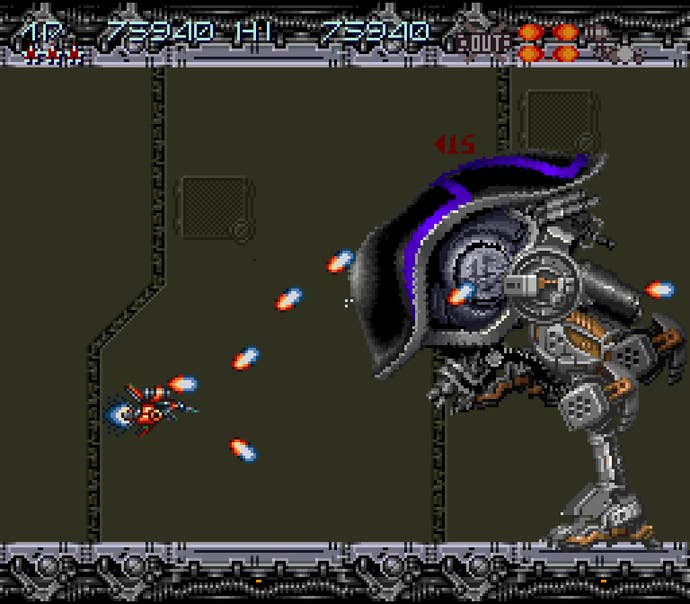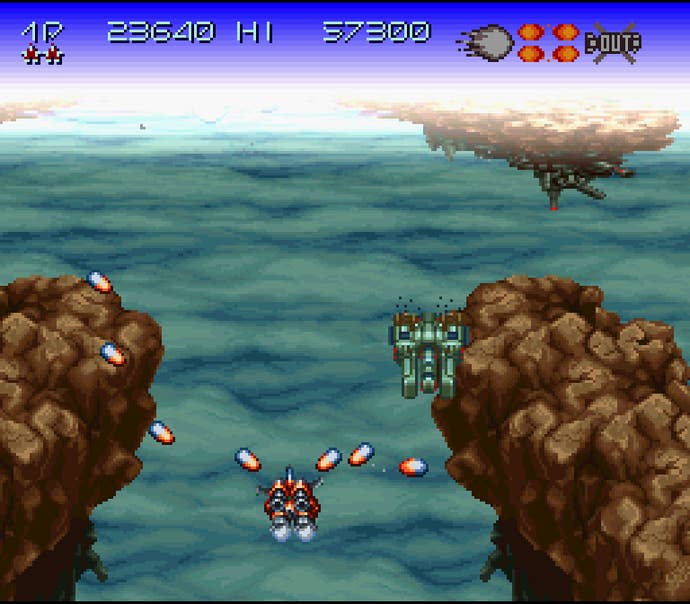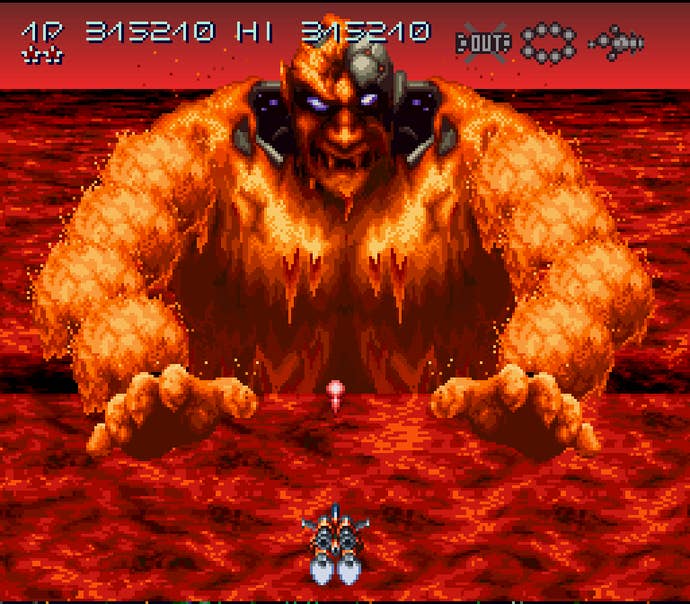Virtual Spotlight: Axelay, The Ultimate Konami Shooter
Age has dulled the shine of this wild shooter's graphical prowess, but not the underlying excellence of its gameplay.
This article first appeared on USgamer, a partner publication of VG247. Some content, such as this article, has been migrated to VG247 for posterity after USgamer's closure - but it has not been edited or further vetted by the VG247 team.
Axelay, the oddly named shoot-em-up that hit Virtual Console last week, doesn't command the same glowing reputation as Konami shooter stablemates like Gradius or even Parodius... probably because, despite the promise of a sequel in the end credits, Axelay never received a follow-up.
Its comparative obscurity should be seen as no strike against the game itself, however. On the contrary, Axelay is a lovely piece of work, Konami at its 16-bit finest. Remember, this was the company that gave us Treasure as a splinter group, and Axelay serves as a great reminder of how much creativity and technical know-how existed inside Konami's walls during the 16-bit era. The game's main hook is its flashy Super NES Mode 7 showpiece, yes, but unlike so many other titles of the era its creators didn't simply come up with a cool gimmick and call it a day. There's meat on these impressive bones.

On top of that, Axelay feels like a tribute to 10 years of Konami shooter history despite not being directly related to any existing series. The stages alternate between horizontal and vertical orientation, much like Life Force (aka Salamander). You pick your weapon loadout before the beginning of each stage, much like Gradius III. Even the enemy patterns at the beginning of the first stage — their animations, the way they scale — call to mind Gyruss. In every sense, Axelay feels like a loving nod to its predecessors.
At the same time, though, it also feels like a Hudson-developed PC Engine shooter that somehow escaped to appear on Super NES. Everything from the visual style (particularly the vintage, pre-Evangelion-era mechs and armored robots) to the armament system calls to mind the Star Soldier games that helped make NEC's console such a favorite among fans of shooting tiny ships in outer space. In fact, the armaments feel far more appropriate to the PC Engine than to a Super NES shooter, allowing you to select three weapons for your ship at the outset of a stage then swapping between them on the fly as circumstances dictate. Your weapon selections range from a spread of needle-thin lasers that curl backward around your ship before seeking targets to a variable bi-directional blaster whose bullet spray can be locked into fixed angles, a sort of predecessor to the egg-aiming mechanic in Yoshi's Island.
Of course, it's not a PC Engine shooter, and you don't have to look hard to find evidence. In fact, the visual gimmick that more or less defines Axelay is an advanced adaptation of a built-in Super NES feature, its hardware Mode 7's ability to render a background as if it were pasted on a cylinder. This graphical trick saw its most memorable application in another Konami title, Super Castlevania IV, but in that case the artists were simply using it to show off a novel programming gimmick. Here, it serves a more explicit purpose: The distorted background bitmaps create the illusion of racing along the surface of a sphere, producing a profound impression of speed in what amounts to a fairly slow-paced shooter.

Admittedly, this background curvature illusion is a lot less convincing now than it was in 1993; now that gaming eyeballs know how three-dimensional objects work as you move through virtual space, watching massive floating rock formations decompress as if being rolled along a spool breaks the illusion of true depth. That being said, though, it's still a cool trick, and at the best of times it looks great.
Much of the credit for the success of the illusion goes to the designers of the game, who clearly put a lot of thought into making the rolling sheet look interactive. In some stages, portions of the background pose collision hazards that force players to see the graphics not as scenery but as genuine threats, particularly the brilliant pipe maze in stage three. Clever sprite work means that active game elements (enemies and bullets) treat the rolling scenery as elements in real space: Sprite-based splashes of magma ripple away as creatures emerge from the molten rock, while fighter craft dodge behind pieces of scenery — again, deepening the general Star Soldier vibe.
Konami's commitment to the visual gimmick counts for a lot, but it can only carry half the game; three of Axelay's six stages play out in a more traditional side-scrolling format that lacks any particular eye-blitzing graphical tricks. Thankfully, these stages benefit from a design choice that factors heavily into the space-bending top-down levels as well: A constant, unrelenting sense of variety.
Axelay falls very much into the linear, memorization-heavy school of shooter design — less about patterns than modern danmaku shooters than about knowing where enemies will appear, and when, and how they'll behave — but it never falls back on simply rehashing slightly tweaked encounter sets as you advance through the stages. You're always facing novel threats, dealing with new foes, facing surprising combinations of environmental and active hazards. So despite consisting of half a dozen stages that can be completed in less than an hour (if you have the necessary skills, of course), Axelay feels like a much lengthier, more substantial shooter.
The Mode 7 features of the Super NES lent themselves to abuse — even great games like ActRaiser often used Mode 7 for little more than a flashy transition or title screen. Axelay stands above its peers for its creators' commitment to content and substance. Its whiz-bang graphical gimmick wasn't an end unto itself by rather the basis for some excellent, imaginative shooting action.

VisualsThese were state of the art two decades ago. Not so much now, but so masterfully crafted you can still appreciate them.
SoundIt's classic Konami, so obviously the music is stunning. The Super NES's trademark muffled sound effects disappoint, though.
InterfaceSimple and straightforward, with the variable weapon system offering as much or as little complexity and control as you want.
Lasting AppealThere's steak to Axelay's sizzle, meaning it's worth a play despite the march of time's dulling effect on its visuals' cutting edge.
ConclusionUnlike many games that throw cutting-edge visuals at players, Axelay stands the test of time; its graphical effects and <em>Macross</em>-inspired mech designs date it as the product of a specific time and era, but its intense and challenging gameplay holds up even now.
